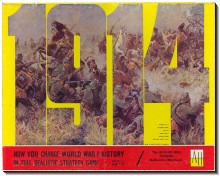
1914 is a board wargame published by Avalon Hill in 1968 that simulates the first few months of World War I on the Western Front.

The Russian Campaign is a strategic board wargame published by Jedko Games in 1974 that simulates combat on the Eastern Front during World War II. Avalon Hill later bought the game and produced several editions.
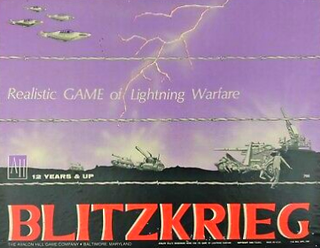
Blitzkrieg is a strategic-level wargame published by Avalon Hill in 1965 that simulates a non-historical attack by one major power against another using the blitzkrieg strategy. It was the first commercial wargame that did not simulate an actual historical battle, and with almost 400 counters, it was a precursor to the "monster" wargames of the 1970s featuring more than a thousand counters.

Napoleon, subtitled "The Waterloo Campaign, 1815", is a strategic-level block wargame published by Gamma Two Games in 1974 that simulates the Battle of Waterloo. A number of versions of the game have been produced by Avalon Hill and Columbia Games.

Tactical wargames are a type of wargame that models military conflict at a tactical level, i.e. units range from individual vehicles and squads to platoons or companies. These units are rated based on types and ranges of individual weaponry. The first tactical wargames were played as miniatures, extended to board games, and they are now also enjoyed as video games.

A block wargame is a board wargame that represents military units using wooden blocks instead of cardboard counters or metal/plastic miniatures.

Kriegsspiel is a genre of wargaming developed by the Prussian Army in the 19th century to teach battlefield tactics to officers. The word Kriegsspiel literally means "wargame" in German, but in the context of the English language it refers specifically to the wargames developed by the Prussian army in the 19th century. Kriegsspiel was the first wargaming system to have been adopted by a military organization as a serious tool for training and research.
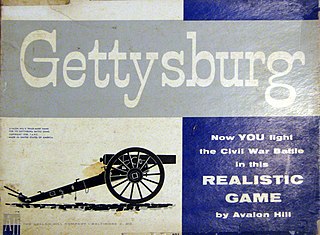
Gettysburg is a board wargame produced by Avalon Hill in 1958 that re-enacts the American Civil War battle of Gettysburg. The game rules were groundbreaking in several respects, and the game, revised several times, was a bestseller for Avalon Hill for several decades.

Stalingrad is a strategic-level board wargame published by Avalon Hill in 1963 that simulates the first 24 months of the war between Germany and the Soviet Union during World War II. As one of the first board wargames it was extensively played and discussed during the early years of the wargaming hobby.

A grand strategy wargame or simply grand strategy game (GSG) is a wargame that places focus on grand strategy: military strategy at the level of movement and use of a nation state or empire's resources. The genre has considerable overlap with 4X games, but differs in being "asymmetrical", meaning that players are more bound to a specific setup and not among equally free factions in exploring and progressing the game and an open world.

A board wargame is a wargame with a set playing surface or board, as opposed to being played on a computer or in a more free-form playing area as in miniatures games. The modern, commercial wargaming hobby developed in 1954 following the publication and commercial success of Tactics. The board wargaming hobby continues to enjoy a sizeable following, with a number of game publishers and gaming conventions dedicated to the hobby both in the English-speaking world and further afield.

Armageddon: Tactical Combat, 3000-500 BC is a board wargame first published by Simulations Publications Inc. (SPI) in 1972 in Strategy & Tactics, then released as a stand-alone game, then reimplemented as Chariot: Tactical Warfare in the "Biblical" Age, 3000-500 BC.

Chitin: I is a science fiction microgame published by Metagaming Concepts in 1977 in which bands of intelligent insects vie for resources.

Fifth Frontier War two-player science fiction board wargame published by Game Designers' Workshop (GDW) in 1981. Fifth Frontier War is the fifth Traveller boardgame published by GDW. It was republished in 2004 as part of Far Future Enterprises Traveller: The Classic Games, Games 1-6+.

Grav Armor is a science fiction tank combat board game published by Heritage Models in 1982.
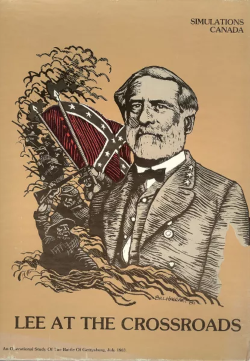
Lee at the Crossroads is a board wargame published by Simulations Canada (SimCan) in 1980 that simulates the 1863 Battle of Gettysburg during the American Civil War. Each player takes the role of one of the opposing commanders, Confederate general Robert E. Lee or Union general George Meade.

Quebec 1759 is a board wargame published in 1972 by Gamma Two Games that simulates the Battle of the Plains of Abraham outside the walls of Quebec in 1759. The game uses wooden blocks set on their edge rather than the more traditional cardboard counters, unique for a wargame in 1972.
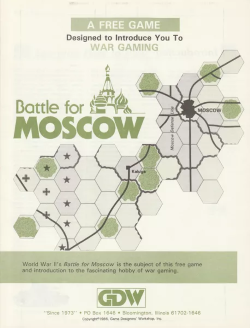
Battle for Moscow is a short and simple board wargame published by Game Designers' Workshop (GDW) in 1986 that simulates Operation Typhoon, the German attempt to quickly capture Moscow during the opening days of their surprise invasion of the Soviet Union in 1941 during World War II. The game was designed as a free giveaway to try to introduce new players to wargaming.
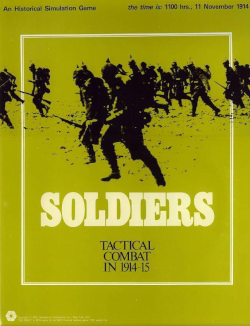
Soldiers: Tactical Combat in 1914–15 is a board wargame published by Simulations Publications Inc. (SPI) in 1972 that simulates the early months of World War I when combatants experienced a degree of mobility before the onset of trench warfare. The game enjoyed positive reviews, and was credited as the influential predecessor of popular tactical games such as Sniper!, StarSoldier, and the bestselling Squad Leader.

Objective Moscow, subtitled "The Death of Soviet Communism", is a board wargame published by Simulations Publications Inc. (SPI) in 1978 that simulates a hypothetical invasion of the U.S.S.R. in 1998 by various forces such as NATO, a united Europe, Iran, and China.



















